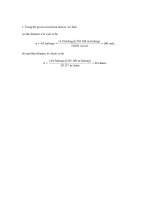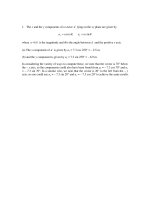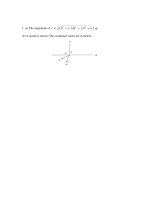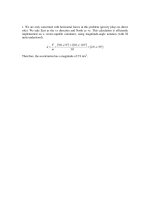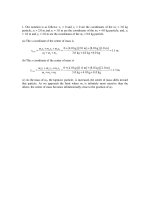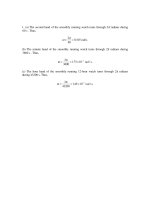Solution manual fundamentals of physics extended, 8th editionch40
Bạn đang xem bản rút gọn của tài liệu. Xem và tải ngay bản đầy đủ của tài liệu tại đây (557.08 KB, 73 trang )
1. (a) For a given value of the principal quantum number n, the orbital quantum number
A ranges from 0 to n – 1. For n = 3, there are three possible values: 0, 1, and 2.
(b) For a given value of A , the magnetic quantum number mA ranges from −A to +A . For
A = 1 , there are three possible values: – 1, 0, and +1.
2. For a given quantum number A there are (2 A + 1) different values of mA . For each
given mA the electron can also have two different spin orientations. Thus, the total
number of electron states for a given A is given by N A = 2(2 A + 1).
(a) Now A = 3, so N A = 2(2 × 3 + 1) = 14.
(b) In this case, A = 1, which means N A = 2(2 × 1 + 1) = 6.
(c) Here A = 1, so N A = 2(2 × 1 + 1) = 6.
(d) Now A = 0, so N A = 2(2 × 0 + 1) = 2.
3. (a) We use Eq. 40-2:
L = A ( A + 1)= = 3 ( 3 + 1) (1.055 × 10−34 J ⋅ s ) = 3.65 ×10−34 J ⋅ s.
(b) We use Eq. 40-7: Lz = mA = . For the maximum value of Lz set mA = A . Thus
[ Lz ]max = A= = 3 (1.055 ×10−34 J ⋅ s ) = 3.16 ×10−34 J ⋅ s.
4. For a given quantum number n there are n possible values of A , ranging from 0 to
n – 1. For each A the number of possible electron states is N A = 2(2 A + 1) . Thus, the
total number of possible electron states for a given n is
n −1
n −1
l =0
l =0
N n = ¦ N A = 2¦
( 2A + 1) = 2n2 .
(a) In this case n = 4, which implies Nn = 2(42) = 32.
(b) Now n = 1, so Nn = 2(12) = 2.
(c) Here n = 3, and we obtain Nn = 2(32) = 18.
c h
(d) Finally, n = 2 → N n = 2 2 2 = 8 .
G
5. The magnitude L of the orbital angular momentum L is given by Eq. 40-2:
L = A(A + 1) = . On the other hand, the components Lz are Lz = mA = , where mA = −A�
,... + A .
Thus, the semi-classical angle is cos θ = Lz / L . The angle is the smallest when m = A , or
cos θ =
With A = 5 , we have θ = 24.1°.
§
·
A=
A
θ = cos −1 ¨
¨ A(A + 1) ¸¸
A(A + 1) =
©
¹
6. (a) For A = 3 , the greatest value of mA is mA = 3 .
(b) Two states ( ms = ± 21 ) are available for mA = 3 .
(c) Since there are 7 possible values for mA : +3, +2, +1, 0, – 1, – 2, – 3, and two possible
values for ms , the total number of state available in the subshell A = 3 is 14.
7. (a) Using Table 40-1, we find A = [ mA ]max = 4.
(b) The smallest possible value of n is n = A max +1 ≥ A + 1 = 5.
(c) As usual, ms = ± 21 , so two possible values.
8. For a given quantum number n there are n possible values of A , ranging from 0 to n − 1 .
For each A the number of possible electron states is N A = 2(2 A + 1). Thus the total
number of possible electron states for a given n is
n −1
n −1
A =0
A =0
N n = ¦ N A = 2¦
( 2A + 1) = 2n2 .
Thus, in this problem, the total number of electron states is Nn = 2n2 = 2(5)2 = 50.
9. (a) For A = 3 , the magnitude of the orbital angular momentum is L = A ( A + 1)= =
3 ( 3 + 1)= = 12= . So the multiple is 12 ≈ 3.46.
b g
(b) The magnitude of the orbital dipole moment is µ orb = A A + 1 µ B = 12 µ B . So the
multiple is 12 ≈ 3.46.
(c) The largest possible value of mA is mA = A = 3 .
(d) We use Lz = mA = to calculate the z component of the orbital angular momentum. The
multiple is mA = 3 .
(e) We use µ z = − mA µ B to calculate the z component of the orbital magnetic dipole
moment. The multiple is − mA = −3 .
(f) We use cosθ = mA
b g
A A + 1 to calculate the angle between the orbital angular
momentum vector and the z axis. For A = 3 and mA = 3 , we have cos θ = 3 / 12 = 3 / 2 ,
or θ = 30.0° .
(g) For A = 3 and mA = 2 , we have cos θ = 2 / 12 = 1/ 3 , or θ = 54.7° .
(h) For A = 3 and mA = −3 , cos θ = −3 / 12 = − 3 / 2 , or θ = 150° .
10. (a) For n = 3 there are 3 possible values of A : 0, 1, and 2.
(b) We interpret this as asking for the number of distinct values for mA (this ignores the
multiplicity of any particular value). For each A there are 2 A + 1 possible values of mA .
Thus the number of possible mA′s for A = 2 is (2 A + 1) = 5. Examining the A = 1 and
A = 0 cases cannot lead to any new (distinct) values for mA , so the answer is 5.
(c) Regardless of the values of n, A and mA , for an electron there are always two possible
values of ms :± 21 .
(d) The population in the n = 3 shell is equal to the number of electron states in the shell,
or 2n2 = 2(32) = 18.
(e) Each subshell has its own value of A . Since there are three different values of A for n
= 3, there are three subshells in the n = 3 shell.
b g
11. Since L2 = L2x + L2y + L2z , L2x + L2y =
L2 − L2z . Replacing L2 with A A + 1 = 2 and Lz
b g
with mA = , we obtain L2x + L2y = = A A + 1 − mA2 . For a given value of A , the greatest that
mA can be is A , so the smallest that
b g
L2x + L2y can be is = A A + 1 − A 2 = = A . The
smallest possible magnitude of mA is zero, so the largest
Thus,
b g
= A ≤ L2x + L2y ≤ = A A + 1 .
b g
L2x + L2y can be is = A A + 1 .
12. (a) From Fig. 40-10 and Eq. 40-18,
∆E = 2 µ B B =
c
hb
2 9.27 × 10−24 J T 0.50 T
. × 10
160
−19
J eV
g = 58 µeV .
(b) From ∆E = hf we get
f =
∆E
9.27 ×10−24 J
=
= 1.4 ×1010 Hz = 14 GHz .
6.63 ×10−34 J ⋅ s
h
(c) The wavelength is
λ=
c 2.998 ×108 m s
=
= 2.1cm.
1.4 ×1010 Hz
f
(d) The wave is in the short radio wave region.
b g d
13. The magnitude of the spin angular momentum is S = s s + 1 = =
s=
1
2
i
3 2 = , where
is used. The z component is either S z = = 2 or − = 2 .
(a) If S z = + = 2 the angle θ between the spin angular momentum vector and the positive
z axis is
θ = cos−1
FG S IJ = cos FG 1 IJ = 54.7° .
HSK
H 3K
z
−1
(b) If S z = − = 2 , the angle is θ = 180° – 54.7° = 125.3° ≈ 125°.
14. (a) From Eq. 40-19,
F = µB
dB
= 9.27 × 10−24 J T 16
. × 102 T m = 15
. × 10−21 N .
dz
c
hc
h
(b) The vertical displacement is
2
1
1 § F · § l · 1 § 1.5 ×10−21 N ·
∆x = at 2 = ¨ ¸ ¨ ¸ = ¨
¸
2
2 © m ¹© v ¹
2 © 1.67 × 10−27 kg ¹
§ 0.80m
¨
5
© 1.2 ×10 m
2
·
−5
¸ = 2.0 ×10 m.
s¹
15. The acceleration is
a=
b
gb
g
µ cosθ dB dz
F
,
=
M
M
where M is the mass of a silver atom, µ is its magnetic dipole moment, B is the magnetic
field, and θ is the angle between the dipole moment and the magnetic field. We take the
moment and the field to be parallel (cos θ = 1) and use the data given in Sample Problem
40-1 to obtain
( 9.27 ×10
a=
−24
J T )(1.4 ×103 T m )
1.8 ×10
−25
kg
= 7.2 × 104 m s .
2
16. We let ∆E = 2µBBeff (based on Fig. 40-10 and Eq. 40-18) and solve for Beff:
Beff =
hc
∆E
1240 nm ⋅ eV
=
=
= 51 mT .
−7
2 µ B 2λµ B 2 21 × 10 nm 5.788 × 10−5 eV T
c
hc
h
G
17. The G energy of a magnetic dipole in an external magnetic field B is
G
G
U = − µ ⋅ B = − µ z B , where µ is the magnetic dipole moment and µz is its component
along the field. The energy required to change the moment direction from parallel to
antiparallel is ∆E = ∆U = 2µzB. Since the z component of the spin magnetic moment of
an electron is the Bohr magneton µ B ,
∆E = 2 µ B B = 2 ( 9.274 × 10−24 J T ) ( 0.200 T ) = 3.71× 10−24 J .
The photon wavelength is
c
hc
h
6.63 × 10−34 J ⋅ s 3.00 × 108 m s
c
hc
= 5.36 × 10−2 m .
λ= =
=
−24
f ∆E
3.71 × 10 J
18. The total magnetic field, B = Blocal + Bext, satisfies ∆E = hf = 2µB (see Eq. 40-22).
Thus,
Blocal
c
hc
h
6.63 × 10−34 J ⋅ s 34 × 106 Hz
hf
− 0.78 T = 19 mT .
=
− Bext =
2µ
. × 10−26 J T
2 141
c
h
19. Because of the Pauli principle (and the requirement that we construct a state of lowest
possible total energy), two electrons fill the n = 1, 2, 3 levels and one electron occupies
the n = 4 level. Thus, using Eq. 39-4,
Eground = 2 E1 + 2 E2 + 2 E3 + E4
FG h IJ b1g + 2 FG h IJ b2g + 2 FG h IJ b3g + FG h IJ b4g
H 8mL K
H 8mL K
H 8mL K H 8mL K
F h IJ = 44 FG h IJ .
= b2 + 8 + 18 + 16g G
H 8mL K H 8mL K
2
=2
2
2
2
2
2
2
2
2
2
Thus, the multiple of h 2 / 8mL2 is 44.
2
2
2
2
2
2
20. Using Eq. 39-20 we find that the lowest four levels of the rectangular corral (with this
specific “aspect ratio”) are non-degenerate, with energies E1,1 = 1.25, E1,2 = 2.00, E1,3 =
3.25, and E2,1 = 4.25 (all of these understood to be in “units” of h2/8mL2). Therefore,
obeying the Pauli principle, we have
b g b g b g
Eground = 2 E1,1 + 2 E1,2 + 2 E1,3 + E2 ,1 = 2 125
. + 2 2.00 + 2 3.25 + 4.25
which means (putting the “unit” factor back in) that the lowest possible energy of the
system is Eground = 17.25(h2/8mL2). Thus, the multiple of h 2 / 8mL2 is 17.25.
21. (a) Promoting one of the electrons (described in problem 19) to a not-fully occupied
higher level, we find that the configuration with the least total energy greater than that of
the ground state has the n = 1 and 2 levels still filled, but now has only one electron in the
n = 3 level; the remaining two electrons are in the n = 4 level. Thus,
E first excited = 2 E1 + 2 E2 + E3 + 2 E4
F h IJ b1g + 2 FG h IJ b2g + FG h IJ b3g + 2 FG h IJ b4g
= 2G
H 8mL K
H 8mL K H 8mL K
H 8mL K
F h IJ = 51FG h IJ .
= b2 + 8 + 9 + 32g G
H 8mL K H 8mL K
2
2
2
2
2
2
2
2
2
2
2
2
2
2
2
2
Thus, the multiple of h 2 / 8mL2 is 51.
(b) Now, the configuration which provides the next higher total energy, above that found
in part (a), has the bottom three levels filled (just as in the ground state configuration) and
has the seventh electron occupying the n = 5 level:
Esecond excited = 2 E1 + 2 E2 + 2 E3 + E5
FG h IJ b1g + 2 FG h IJ b2g + 2 FG h IJ b3g + FG h IJ b5g
H 8mL K
H 8mL K
H 8mL K H 8mL K
F h IJ = 53FG h IJ .
= b2 + 8 + 18 + 25g G
H 8mL K H 8mL K
2
=2
2
2
2
2
2
2
2
2
2
2
2
2
2
2
2
Thus, the multiple of h 2 / 8mL2 is 53.
(c) The third excited state has the n = 1, 3, 4 levels filled, and the n = 2 level half-filled:
E third excited = 2 E1 + E2 + 2 E3 + 2 E4
FG h IJ b1g + FG h IJ b2g + 2 FG h IJ b3g + 2 FG h IJ b4g
H 8mL K H 8mL K
H 8mL K
H 8mL K
F h IJ = 56 FG h IJ .
= b2 + 4 + 18 + 32g G
H 8mL K H 8mL K
2
=2
2
2
2
2
2
2
2
2
2
2
2
2
2
2
2
Thus, the multiple of h 2 / 8mL2 is 56.
(d) The energy states of this problem and problem 19 are suggested in the sketch below:
_______________________ third excited 56(h2/8mL2)
_______________________ second excited 53(h2/8mL2)
_______________________ first excited 51(h2/8mL2)
_______________________ ground state 44(h2/8mL2)
22. (a) Using Eq. 39-20 we find that the lowest five levels of the rectangular corral (with
this specific “aspect ratio”) have energies E1,1 = 1.25, E1,2 = 2.00, E1,3 = 3.25, E2,1 = 4.25,
and E2,2 = 5.00 (all of these understood to be in “units” of h2/8mL2). It should be noted
that the energy level we denote E2,2 actually corresponds to two energy levels (E2,2 and
E1,4; they are degenerate), but that will not affect our calculations in this problem. The
configuration which provides the lowest system energy higher than that of the ground
state has the first three levels filled, the fourth one empty, and the fifth one half-filled:
b g b g b g
E first excited = 2 E1,1 + 2 E1,2 + 2 E1,3 + E2 ,2 = 2 125
. + 2 2.00 + 2 3.25 + 5.00
which means (putting the “unit” factor back in) the energy of the first excited state is
Efirst excited = 18.00(h2/8mL2). Thus, the multiple of h 2 / 8mL2 is 18.00.
(b) The configuration which provides the next higher system energy has the first two
levels filled, the third one half-filled, and the fourth one filled:
Esecond excited = 2 E1,1 + 2 E1,2 + E1,3 + 2 E2,1 = 2 (1.25 ) + 2 ( 2.00 ) + 3.25 + 2 ( 4.25 )
which means (putting the “unit” factor back in) the energy of the second excited state is
Esecond excited = 18.25(h2/8mL2). Thus, the multiple of h 2 / 8mL2 is 18.25.
(c) Now, the configuration which provides the next higher system energy has the first two
levels filled, with the next three levels half-filled:
Ethird excited = 2 E1,1 + 2 E1,2 + E1,3 + E2,1 + E2,2 = 2 (1.25 ) + 2 ( 2.00 ) + 3.25 + 4.25 + 5.00
which means (putting the “unit” factor back in) the energy of the third excited state is
Ethird excited = 19.00(h2/8mL2). Thus, the multiple of h 2 / 8mL2 is 19.00.
(d) The energy states of this problem and problem 20 are suggested in the sketch below:
__________________ third excited 19.00(h2/8mL2)
__________________ second excited 18.25(h2/8mL2)
__________________ first excited 18.00(h2/8mL2)
__________________ ground state 17.25(h2/8mL2)
23. In terms of the quantum numbers nx, ny, and nz, the single-particle energy levels are
given by
E n x , n y ,nz =
h2
nx2 + n y2 + nz2 .
8mL2
d
i
The lowest single-particle level corresponds to nx = 1, ny = 1, and nz = 1 and is E1,1,1 =
3(h2/8mL2). There are two electrons with this energy, one with spin up and one with spin
down. The next lowest single-particle level is three-fold degenerate in the three integer
quantum numbers. The energy is
E1,1,2 = E1,2,1 = E2,1,1 = 6(h2/8mL2).
Each of these states can be occupied by a spin up and a spin down electron, so six
electrons in all can occupy the states. This completes the assignment of the eight
electrons to single-particle states. The ground state energy of the system is
Egr = (2)(3)(h2/8mL2) + (6)(6)(h2/8mL2) = 42(h2/8mL2).
Thus, the multiple of h 2 / 8mL2 is 42.
24. We use the results of problem 22 in Chapter 39. The Pauli principle requires that no
more than two electrons be in the lowest energy level (at E1,1,1 = 3(h2/8mL2)), but — due
to their degeneracies — as many as six electrons can be in the next three levels
E' = E1,1,2 = E1,2,1 = E2,1,1 = 6(h2/8mL2)
E'' = E1,2,2 = E2,2,1 = E2,1,2 = 9(h2/8mL2)
E''' = E1,1,3 = E1,3,1 = E3,1,1 = 11(h2/8mL2).
Using Eq. 39-21, the level above those can only hold two electrons:
E2,2,2 = (22 + 22 + 22)(h2/8mL2) = 12(h2/8mL2).
And the next higher level can hold as much as twelve electrons (see part (e) of problem
22 in Chapter 39) and has energy E'''' = 14(h2/8mL2).
(a) The configuration which provides the lowest system energy higher than that of the
ground state has the first level filled, the second one with one vacancy, and the third one
with one occupant:
bg bg
E first excited = 2 E1,1,1 + 5E ′ + E ′′ = 2 3 + 5 6 + 9
which means (putting the “unit” factor back in) the energy of the first excited state is
Efirst excited = 45(h2/8mL2). Thus, the multiple of h 2 / 8mL2 is 45.
(b) The configuration which provides the next higher system energy has the first level
filled, the second one with one vacancy, the third one empty, and the fourth one with one
occupant:
bg bg
Esecond excited = 2 E1,1,1 + 5E ′ + E ′′ = 2 3 + 5 6 + 11
which means (putting the “unit” factor back in) the energy of the second excited state is
Esecond excited = 47(h2/8mL2). Thus, the multiple of h 2 / 8mL2 is 47.
(c) Now, there are a couple of configurations which provide the next higher system
energy. One has the first level filled, the second one with one vacancy, the third and
fourth ones empty, and the fifth one with one occupant:
bg bg
E third excited = 2 E1,1,1 + 5E ′ + E ′′′ = 2 3 + 5 6 + 12
which means (putting the “unit” factor back in) the energy of the third excited state is
Ethird excited = 48(h2/8mL2). Thus, the multiple of h 2 / 8mL2 is 48. The other configuration
